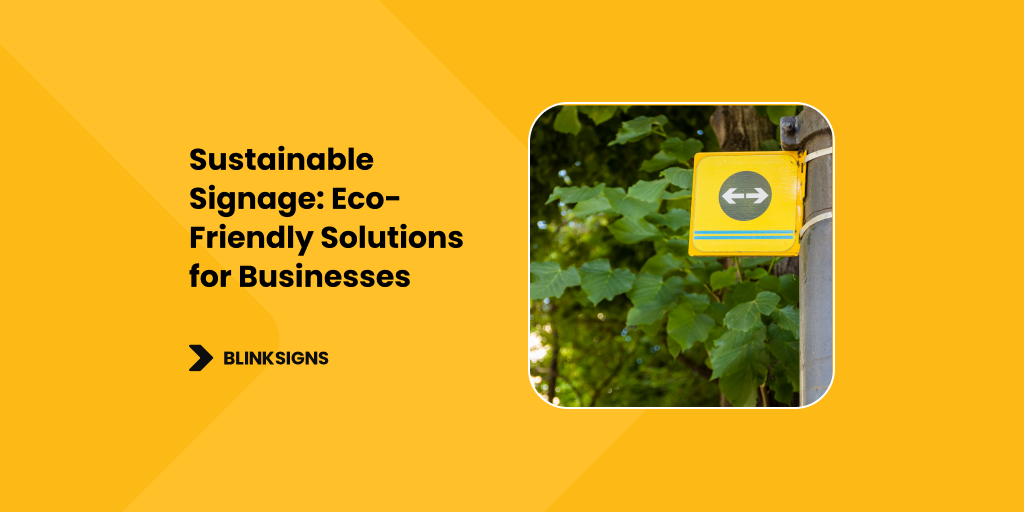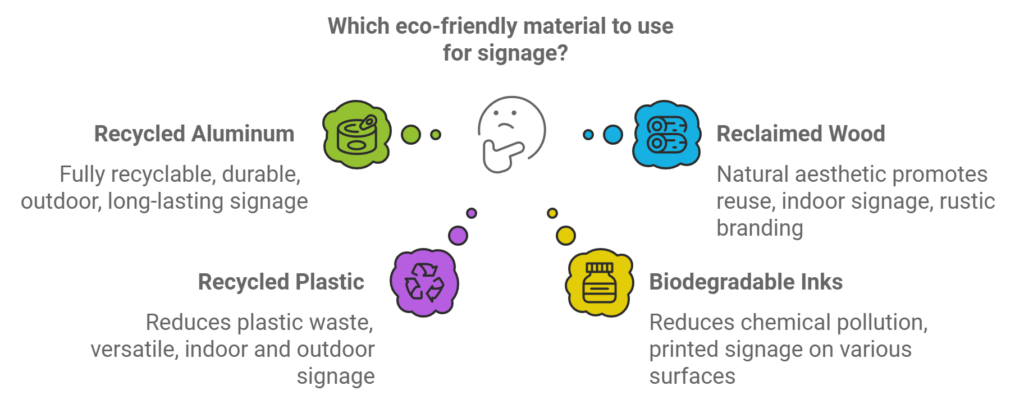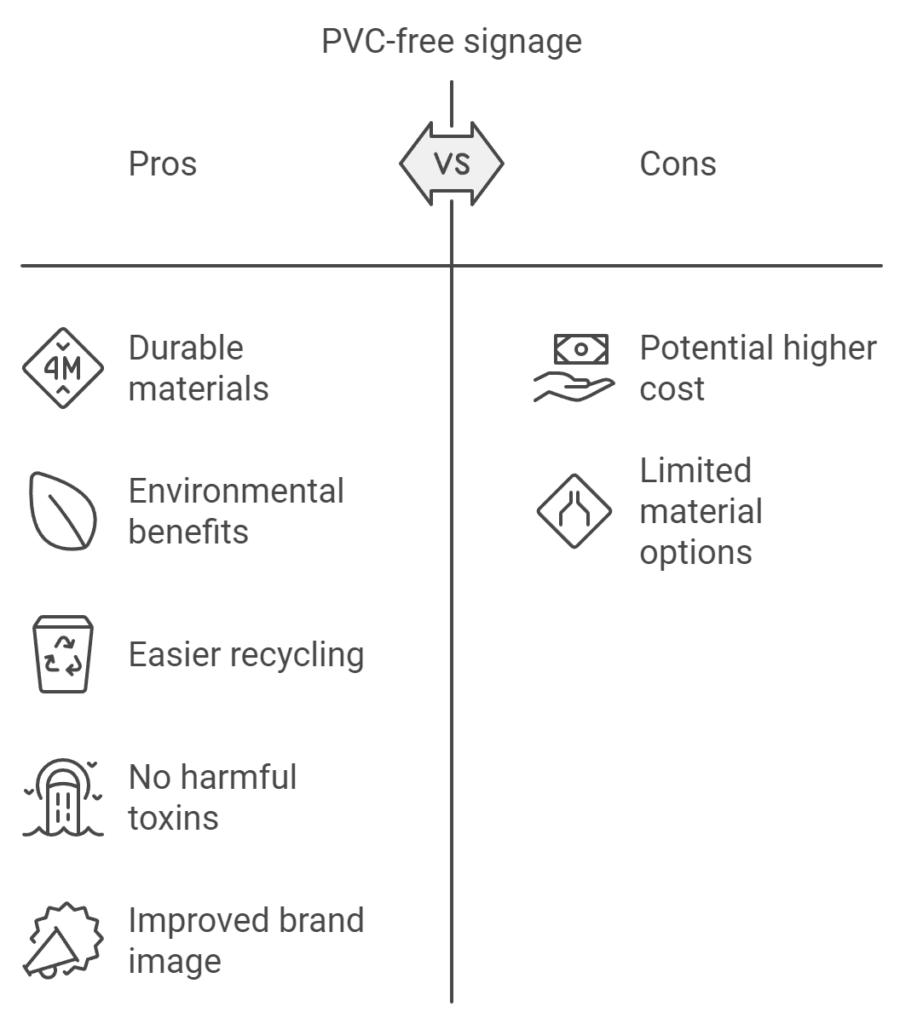
Sustainable Signage: Eco-Friendly Solutions for Businesses
Sustainability is increasingly becoming a core focus for businesses worldwide. One of the most impactful ways to contribute to this goal is by adopting sustainable signage. Blinksigns, a leading signage solutions provider, offers eco-friendly signage options that utilize recycled materials, energy-efficient lighting, and modular designs. These solutions not only help businesses reduce their environmental footprint but also enhance brand visibility, making sustainable signage a practical and responsible choice.
What is Sustainable Signage, and Why Does It Matter?
Sustainable signage uses eco-friendly materials and technologies that minimize environmental impact. Businesses can lower their waste output by choosing signage made from recycled, renewable, and biodegradable materials while maintaining high-quality design and functionality. Blinksigns integrates LED and solar-powered lighting systems into their signage to further reduce energy consumption and operational costs.
Sustainable signage is crucial for businesses aligning with growing consumer expectations for eco-conscious practices. It helps companies reduce their carbon footprint, meet regulatory standards, and build a positive brand image. Blinksigns ensures that businesses can adopt sustainable signage that not only meets industry standards but also resonates with environmentally aware customers.
Key Benefits of Sustainable Signage for Businesses
Sustainable signage offers a variety of benefits that extend beyond reducing environmental impact. One key advantage is cost reduction. Blinksigns uses energy-efficient lighting systems such as LEDs and solar power to help businesses cut their electricity bills and minimize maintenance costs. LEDs consume significantly less energy than traditional lighting systems, leading to long-term savings.
Furthermore, recycled materials like aluminium and reclaimed wood are highly durable, meaning fewer replacements are needed, further reducing operational costs. Sustainable signage also improves a business’s reputation. Consumers are increasingly prioritizing sustainability when choosing brands, and businesses that embrace eco-friendly signage solutions from Blinksigns are seen as forward-thinking and responsible.
Best Eco-Friendly Materials for Sustainable Signage

Eco-friendly material for signage
Choosing the right materials is vital for achieving sustainability goals. Blinksigns provides businesses with a wide range of eco-friendly materials designed to reduce environmental impact while ensuring durability and aesthetic appeal. Recycled aluminium is one of the most durable materials for outdoor signage. Its lightweight, rust-resistant properties and its ability to be fully recycled make it ideal for companies looking to minimize waste.
Reclaimed wood is a sustainable option for indoor signage that adds a natural, rustic touch. It promotes material reuse, lowering the demand for new resources. Recycled plastic is another versatile material that works well for indoor and outdoor applications, helping reduce plastic waste. Additionally, biodegradable inks used by Blinksigns ensure that printed signs don’t release harmful chemicals into the environment during production.
| Material | Sustainability Benefit | Best Use Case |
| Recycled Aluminum | Fully recyclable, durable | Outdoor, long-lasting signage |
| Reclaimed Wood | Natural aesthetic promotes reuse | Indoor signage, rustic branding |
| Recycled Plastic | Reduces plastic waste, versatile | Indoor and outdoor signage |
| Biodegradable Inks | Reduces chemical pollution | Printed signage on various surfaces |
How to Make Your Business Signage More Sustainable
Businesses can make their signage more sustainable by selecting the right materials and implementing energy-efficient solutions. Blinksigns helps companies choose recycled materials like aluminium and wood, which are durable and eco-friendly. These materials reduce waste and offer long-term cost savings by minimizing the need for replacements.
Energy-efficient lighting is another critical aspect of sustainable signage. LED lighting, which Blinksigns offers, uses up to 80% less energy than traditional lighting and has a longer lifespan, reducing the overall energy footprint and maintenance costs. Solar-powered signage is an ideal option for businesses looking to take their sustainability efforts a step further. Solar-powered signs capture energy from the sun, making them a 100% renewable and sustainable solution.
LED and Solar-Powered Signage: Energy Efficiency at its Best
Energy-efficient lighting solutions are at the heart of sustainable signage. Blinksigns specializes in providing LED signage, which uses a fraction of the energy required by traditional lighting systems. LED lights are not only highly energy-efficient but also offer 50,000+ hours of lifespan, meaning fewer replacements and reduced maintenance costs over time.
Solar-powered signage is another advanced option offered by Blinksigns. Solar signs harness energy from the sun to keep signage illuminated, significantly reducing reliance on grid electricity. This is an ideal solution for outdoor applications, providing both cost savings and environmental benefits. Solar-powered signage allows businesses to operate signs in remote locations or areas with minimal access to the power grid, further expanding its utility.
Modular Signage Systems for Sustainability
Frequent updates to signage can create unnecessary waste. However, modular signage systems provided by Blinksigns offer a sustainable solution. Modular signage allows businesses to change specific components of their signs—such as text, logos, or graphics—without replacing the entire sign. This reduces waste and lowers overall costs, making modular signage an excellent choice for industries with frequently changing messaging, such as retail, hospitality, and events.
Modular signage also provides greater flexibility. Businesses can update their branding or promotional content easily without the need for costly replacements. By choosing modular signage from Blinksigns, businesses can stay responsive to market changes while keeping their environmental impact to a minimum.
- Flexibility: Modular designs allow easy updates without replacing the entire sign, reducing waste and saving costs.
- Sustainability: Ideal for industries with frequent changes, modular signage minimizes material usage and promotes reuse.
Eco-Friendly Disposal and Recycling of Old Signage
When businesses upgrade to new signage, properly disposing of old signs is crucial. Blinksigns offers eco-friendly disposal and recycling options for materials like aluminium, plastic, and steel. Recycling these materials helps reduce waste that would otherwise end up in landfills, supporting a more circular economy.
Businesses should also consider replacing older signage made from PVC. PVC is difficult to recycle and can release harmful chemicals when incinerated. Blinksigns offers sustainable alternatives such as polypropylene and acrylic, which are much easier to recycle and pose less environmental risk. Companies can ensure that their signage lifecycle aligns with their sustainability goals by choosing eco-friendly materials.
Why PVC-Free Signage Matters for Environmental Sustainability
PVC (polyvinyl chloride) has been a common material in traditional signage, but it poses significant environmental risks. PVC production generates harmful chemicals, and its disposal can lead to long-term pollution. As businesses strive to meet modern sustainability standards, choosing PVC-free signage is an essential step in reducing environmental impact.

PVC-free signage
Blinksigns provides a variety of PVC-free materials, such as polypropylene, acrylic, and recycled plastics, which offer both durability and environmental benefits. These materials are easier to recycle and don’t release harmful toxins during production or disposal. By opting for PVC-free signage, businesses can demonstrate their commitment to sustainability, improve their brand image, and reduce their carbon footprint.
Cost-Effective Sustainable Signage Solutions for Small Businesses
Sustainable signage is accessible for businesses of all sizes, including small companies. Blinksigns offers cost-effective, eco-friendly signage solutions that help small businesses reduce their environmental footprint without incurring excessive costs. Recycled plastics and reclaimed wood are affordable options, allowing businesses to reduce waste and enhance their brand image.
LED lighting provides additional savings, with reduced energy costs and longer lifespans than traditional lighting. Modular signage systems offer a smart, sustainable solution for businesses that frequently update their signage—whether for promotions, seasonal changes, or new product launches. Businesses can use modular systems to update specific sign parts without replacing the entire structure, reducing material costs and environmental impact.
- Affordable Materials: Recycled plastics and reclaimed wood provide cost-effective, sustainable signage options.
- Long-Term Savings: LED lighting reduces energy costs and extends the lifespan of signs, reducing maintenance and replacement costs.
How Sustainable Signage Enhances Brand Reputation
Adopting sustainable signage does more than help businesses reduce their environmental impact—it enhances brand reputation. Consumers today expect companies to prioritize sustainability, and businesses that use eco-friendly signage from Blinksigns demonstrate their commitment to responsible practices. Incorporating recycled materials, energy-efficient lighting, and PVC-free options strengthens a brand’s position as a leader in sustainability.
Sustainable signage helps companies connect with eco-conscious consumers, improve customer loyalty, and stand out from competitors.
Blinksigns ensures businesses can boost their brand image by adopting green practices that resonate with modern consumers and contribute to long-term business success.
Conclusion
Sustainable signage is a powerful tool for businesses looking to reduce their environmental impact, cut costs, and improve their brand image. With Blinksigns, businesses can choose from a wide range of eco-friendly signage solutions, including recycled materials, energy-efficient lighting, and modular designs.
These solutions provide financial and environmental benefits, helping businesses stay competitive while contributing to a more sustainable future.